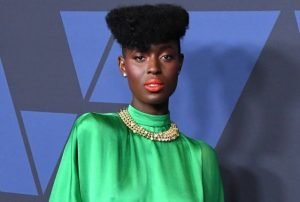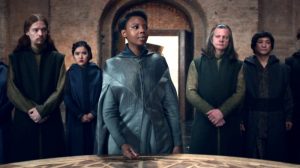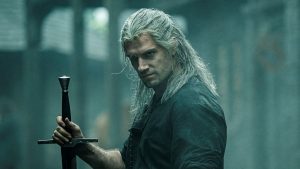SPOILERS FOR WANDAVISION AHEAD!
It seems we’re not the only ones who can’t get enough of WandaVision, and the opportunities it gives us to come up with theories, endlessly debate possible clues, and have fun in the vast sandbox that is the Marvel Cinematic Universe. Coming off a shockingly strong third episode, WandaVision now turns its focus to events happening in the “real” MCU, outside the magical force-field encircling or entrapping Wanda’s suburban utopia of Westview…and allowing us to witness everything from new perspectives, putting many of the series’ most bizarre moments into context.

But the absurdity of the show hasn’t decreased a bit: how could it, with the reveal that WandaVision‘s sitcom adventures are indeed being broadcast onto every vintage TV within a 5-mile radius of Westview, giving familiar MCU heroes a chance to develop their own theories about what’s going on? It’s getting pretty meta around here, so let’s dive right in.
The fourth episode is roughly split down the middle by a small time jump, with the first ten minutes or so following S.W.O.R.D. Agent Monica Rambeau (Teyonah Parris), and the remaining twenty minutes mostly focusing on astrophysicist Darcy Lewis (Kat Dennings): both are returning characters from other MCU properties who, for a variety of reasons, have gotten entangled in a bizarre missing persons case in rural New Jersey…or rather, a missing town case. These two characters form the crux of the episode, and their brilliant performances make this interruption from the regular program both worthwhile and entertaining, but neither are able to fully overcome an infuriating time constraint that forces them to jump from one plot-point to the next like pinballs.
Monica’s part of the episode starts off extremely strong, as she’s in the process of being spontaneously resurrected from scraps of floating dust and ash – in what Spider-Man: Far From Home humorously referred to as “the Blip”, the moment when the half of Earth’s population that had been snapped out of existence by Thanos was suddenly brought back to life in Avengers: Endgame. Far From Home used the concept as an excuse for light comedy, but WandaVision‘s darker tone allows the series freedom to explore the event’s catastrophic aftermath: in Monica’s case, a hospital suddenly overcrowded by hundreds of patients being resurrected in their beds or in hallways, causing a panicked stampede. But for Monica, who has no recollection of being snapped and no idea what’s going on, there’s a more pressing issue before her: the death of her mother, Maria Rambeau, who was being treated for cancer five years before when Monica snapped while waiting beside her hospital bed for her to wake up after surgery.
The reveal that Maria and her daughter never got to say goodbye is heart-wrenching, particularly because we in the audience knew how much Maria loved Monica just from her one appearance in Captain Marvel. I know I shouldn’t have to write a eulogy for a fictional character, but Maria Rambeau was instantly charismatic, vivacious, energetic, and a daring yet coolheaded adventurer. WandaVision reveals that she was also one of the founding members of S.W.O.R.D., and helped set up guidelines in case the vanished, including her own daughter, ever returned one day. I know that Maria’s death is probably real and irreversible…but oh, I want to believe that she faked her own death and is up in space on Nick Fury’s secret space-station, working on some top-secret mission. I theorized a while ago that Maria and Monica would be a mother/daughter S.W.O.R.D. Agent duo, and I was right, but not in the way I’d imagined. I’m disappointed that such a potentially dynamic relationship was pushed offscreen, and deeply sad that one of the MCU’s few Black heroines has already died so tragically.

Monica, who works at S.W.O.R.D. helping to observe and respond to threats posed by “sentient weapons” (and cautions her boss that S.W.O.R.D. shouldn’t be designing sentient weapons themselves, possible foreshadowing some future conflict), returns to work after the Blip only to find herself “grounded”, i.e. restricted to terrestrial missions. This at least confirms that S.W.O.R.D. has an interstellar presence, something we all questioned when the organization’s new acronym was revealed. It’s all part of Maria’s plan to stabilize agents left traumatized by the Snap and the Blip, but Monica is understandably upset until she becomes invested in her new assignment: helping the FBI track down an entire town in New Jersey, that’s disappeared behind a glowing force-field, leaving those outside the bubble with no recollection of the town, or its citizens. A bit like Beauty & The Beast – which also involves a powerful sorceress turning a group of innocent people into warped versions of themselves.
Unfortunately, we don’t get to spend much time with Teyonah Parris’ Monica before she vanishes into the force-field too, leaving the only witness, FBI agent Jimmy Woo (Randall Park), horrified and in urgent need of backup. Maybe without that thirty-five minute mark looming on the horizon, we would have had more time to see Monica’s life beyond her work. A single scene of her visiting Maria’s grave could have gone a long way, as trope-y as it sounds.
The episode’s second half picks up twenty-four hours later, as an armored truckload of scientific professionals are escorted into the S.W.O.R.D./FBI camp outside Westview – one of those professionals being Darcy, whom we haven’t seen since 2013’s Thor: The Dark World, back when she was still an intern to Jane Foster (who I guess is too busy being Thor to answer S.W.O.R.D.’s calls right now?). She hasn’t changed a bit: her unshakable sense of humor injects the perfect amount of levity into the intense atmosphere. And it takes her no time at all to discover that, for whatever reason, Westview is broadcasting episodes of WandaVision onto vintage TV sets: revealing to S.W.O.R.D. that superheroine Wanda Maximoff (Elizabeth Olsen) is behind the recent disappearances.
I have to admit, I do love indulging in the nifty meta humor of watching S.W.O.R.D. Agents pick apart every detail in the WandaVision broadcasts, only to now do the same to the S.W.O.R.D. Agents myself. Marvel is lovingly teasing us keen-eyed fans, taking it right up to the brink of parody with visuals like Jimmy Woo’s giant whiteboard of theories (he seems perplexed by the hexagon imagery prevalent in Westview: it’s clearly because the number 6 is associated with the devil, a.k.a. Mephisto!). Darcy and Jimmy even get too invested in the series, sharing snacks while waiting for Wanda to have her twins. They’re like highly-trained fandom theorists, but we in the real world have an advantage over them: because WandaVision‘s broadcasts to the MCU choppily edit out all the scenes in which Wanda loses control over her reality – something that confuses S.W.O.R.D. nearly as much as it does me.
Dinner with the Harts, Dottie’s exploding lemonade glass, the beekeeper…all of it’s been cut by some supernatural network censor. S.W.O.R.D.’s attempts to break through to Wanda with drones, radio transmissions, and human agents, all end in failure as anything that goes into Westview becomes distorted by Wanda’s reality-bending magic. Unfortunately for S.W.O.R.D., that means they miss the best part of episode three, when Wanda turns on Monica and throws her out of Westview: they only experience the aftermath, as Monica comes flying out of the sky and crashes into the S.W.O.R.D. camp.
Thankfully, we the audience are treated to a flashback to that same encounter, but from Monica’s POV. Last week’s episode ended before we could see how things went down, but now we get to witness the violent power of Wanda’s hex-magic as she propels Monica through the side of her house and across town, hurriedly repairing the wall just moments before Vision (Paul Bettany) enters. As Wanda and Monica face off, the aspect ratio shifts as well as the style of Elizabeth Olsen’s acting (and nary a laugh-track to be heard), indicating that Wanda isn’t confused or conflicted about what’s going on: her fantasy has been disturbed by Monica’s presence, and to protect it she momentarily has to break the fantasy façade she’s built to deal with the intruder. This is followed by a freaky jump-scare moment from Wanda’s POV as she turns to greet Vision – and briefly sees him as a gray, corpse-like figure with blank eyes and a hole gouged out of his forehead. Her reality is splitting open, despite her claims that she has everything under control.

The strong implication of this week’s episode is that everything in Westview is entirely Wanda’s doing. Wanda says so herself, and Monica’s first words after her crash-landing are “It’s Wanda…it’s all Wanda”. But I’m not buying it, and I’m not willing to accept S.W.O.R.D.’s findings as fact when they’re not even working with the same information we have. As I’ve said before, I think Wanda has some control over Westview, but I believe that’s a small concession on the part of whatever greater power actually designed this pocket dimension for her to inhabit, and is now using it to ensnare her children.
At least this episode will encourage us all to step up our theorizing game if we’re to beat S.W.O.R.D. to the answers. Time will tell if it was wise to introduce the MCU’s next great wave of space-based heroes as essentially a group of over-eager Wanda stans investigating Lizzie’s every move, but hey, it gives us a weirdly fun challenge to look forward to as viewers, so…I’m not complaining.
Episode Rating: 7.9/10








